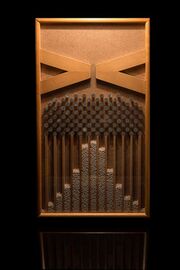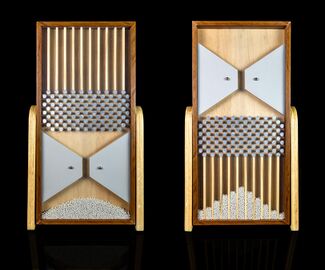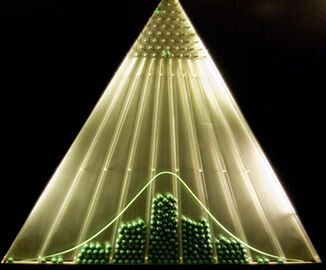Bean machine
File:Galton box.webm The bean machine, also known as the Galton Board or quincunx, is a device invented by Sir Francis Galton[1] to demonstrate the central limit theorem, in particular that with sufficient sample size the binomial distribution approximates a normal distribution. Among its applications, it afforded insight into regression to the mean or "reversion to mediocrity".
Description
The Galton Board consists of a vertical board with interleaved rows of pegs. Beads are dropped from the top and, when the device is level, bounce either left or right as they hit the pegs. Eventually they are collected into bins at the bottom, where the height of bead columns accumulated in the bins approximate a bell curve. Overlaying Pascal's triangle onto the pins shows the number of different paths that can be taken to get to each bin.[2]
Large-scale working models of this device created by Charles and Ray Eames can be seen in the A World of Numbers... and Beyond exhibits permanently on view at the Boston Museum of Science, the New York Hall of Science, or the Henry Ford Museum.[3] Another large-scale version is displayed in the lobby of Index Fund Advisors in Irvine, California.[4]
Bean machines can be constructed for other distributions by changing the shape of the pins or biasing them towards one direction, and even bimodal bean machines are possible.[5] A bean machine for the log-normal distribution (common in many natural processes, particularly biological ones), which uses isosceles triangles of varying widths to 'multiply' the distance the bead travels instead of fixed sizes steps which would 'sum', was constructed by Jacobus Kapteyn while studying and popularizing the statistics of the log-normal in order to help visualize it & demonstrate its plausibility.[6] As of 1963, it was preserved in the University of Groningen.[7] An improved log-normal bean machine, using skewed triangles, which avoids shifting the median of the beads to the left.[8]
Distribution of the beads
If a bead bounces to the right k times on its way down (and to the left on the remaining pegs) it ends up in the kth bin counting from the left. Denoting the number of rows of pegs in a Galton Board by n, the number of paths to the kth bin on the bottom is given by the binomial coefficient [math]\displaystyle{ {n\choose k} }[/math]. Note that the leftmost bin is the 0-bin, next to it is the 1-bin, etc. and the furthest one to the right is the n-bin - making thus the total number of bins equal to n+1 (each row does not need to have more pegs than the number that identifies the row itself, e.g. the first row has 1 peg, the second 2 pegs, until the n-th row that has n pegs which correspond to the n+1 bins). If the probability of bouncing right on a peg is p (which equals 0.5 on an unbiased level machine) the probability that the ball ends up in the kth bin equals [math]\displaystyle{ {n\choose k} p^k (1-p)^{n-k} }[/math]. This is the probability mass function of a binomial distribution. The number of rows correspond to the size of a binomial distribution in number of trials, while the probability p of each pin is the binomial's p.
According to the central limit theorem (more specifically, the de Moivre–Laplace theorem), the binomial distribution approximates the normal distribution provided that the number of rows and the number of balls are both large. Varying the rows will result in different standard deviations or widths of the bell-shaped curve or the normal distribution in the bins.
Examples
The bean machine, as drawn by Sir Francis Galton
History
Sir Francis Galton was fascinated with the order of the bell curve that emerges from the apparent chaos of beads bouncing off of pegs in the Galton Board. He eloquently described this relationship in his book Natural Inheritance (1889):
Order in Apparent Chaos: I know of scarcely anything so apt to impress the imagination as the wonderful form of cosmic order expressed by the Law of Frequency of Error. The law would have been personified by the Greeks and deified, if they had known of it. It reigns with serenity and in complete self-effacement amidst the wildest confusion. The huger the mob, and the greater the apparent anarchy, the more perfect is its sway. It is the supreme law of Unreason. Whenever a large sample of chaotic elements are taken in hand and marshalled in the order of their magnitude, an unsuspected and most beautiful form of regularity proves to have been latent all along.[1]:66
Games
Several games have been developed utilizing the idea of pins changing the route of balls or other objects:
- Pachinko
- Payazzo
- Peggle
- Pinball
- Plinko
- The Wall
References
- ↑ Jump up to: 1.0 1.1 Galton, Sir Francis (1894). Natural Inheritance. Macmillan. https://archive.org/details/naturalinherita01galtgoog. ISBN:978-1297895982
- ↑ "The Galton Board" (in en). Four Pines Publishing, Inc.. http://www.galtonboard.com. Retrieved 2018-03-06.
- ↑ "Henry Ford museum acquires Eames' Mathematica exhibit". LiveAuctioneers. 20 March 2015. https://www.liveauctioneers.com/news/top-news/museums/henry-ford-museum-acquires-eames-mathematica-exhibit/. Retrieved 2018-03-06.
- ↑ "IFA.tv - From Chaos to Order on the Galton Board -- A Random Walker". 23 December 2009. https://www.youtube.com/watch?v=9xUBhhM4vbM&t=10s. Retrieved 2018-03-06.
- ↑ Brehmer et al 2018, "Mining gold from implicit models to improve likelihood-free inference": "Simulator Mining Example"
- ↑ Kapteyn 1903, Skew frequency curves in biology and statistics v1; Kapteyn & van Uven 1916, Skew frequency curves in biology and statistics v2
- ↑ Aitchison & Brown 1963, The Lognormal Distribution, with Special Reference to its Uses in Economics
- ↑ Limpert et al 2001, "Log-normal Distributions across the Sciences: Keys and Clues"
External links
- Galton Board informational website with resource links
- An 8-foot-tall (2.4 m) Probability Machine (named Sir Francis) comparing stock market returns to the randomness of the beans dropping through the quincunx pattern. from Index Fund Advisors IFA.com
- Quincunx and its relationship to normal distribution from Math Is Fun
- A multi-stage bean machine simulation (JS)
- Pascal's Marble Run: a deterministic Galton board
- Log-normal bean machine (animation)
- A music video featuring a Galton board by Carl McTague






